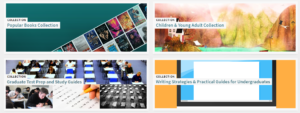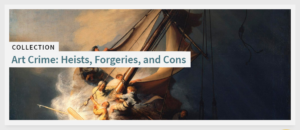6 Curated Collections for First- and Second-Year Students
Bringing virtual browsing to the discovery experience
Rebecca Nous and Lauren Puzier
“By supporting browsable collections, libraries help students actively participate in the research and knowledge creation process…finding information by chance while browsing helps spark student research interests and encourages intellectual curiosity.”
Introduction
The University at Albany is a comprehensive research university located in New York’s capital district, and is one of four University Centers in the State University of New York system. More than three-quarters of the University’s approximately 17,000 students are undergraduates. Supporting first-year students is one of the University’s goals. When students enroll at the University, they select one of several First-Year Student programs designed to help them successfully transition to college life and learning. Options include living-learning communities that create a cohort of students with similar interests and academic goals, a zero-credit engagement course that introduces students to support systems, faculty, and activities around campus, and credit-bearing courses that foster relationships between students and faculty and build skills for academic success.
The University Libraries supports the research, teaching, and learning activities of all students, faculty, and staff at the University as well as community members. Library faculty often participate in the University’s First-Year Student programs and teach courses included in them. We are also developing our own creative ways to support first-year students as they adjust to academics at the college level through events, programs, and research support services. From targeted content on our website, such as a Back to School FAQ with questions new students would frequently ask about the University Libraries, to the Award for Outstanding Undergraduate Research, which early career undergraduates are encouraged to apply for, the University Libraries is working to support new students in a variety of ways. Recently, we have also been exploring ways to leverage our discovery tool, Primo VE, to support our new undergraduate students’ research and learning needs.
Browsing, Intellectual Curiosity, and Information Discovery
Undergraduate research often starts with topics or questions that are ill-defined or open-ended, which are particularly well-suited to exploratory research methods. Exploratory browsing consists of three primary activities: discovery, learning, and investigation (White & Roth, 2009). Discovery is the process of encountering and identifying new, previously unknown information. Learning is the process of making sense of this newly discovered information, leading to a deeper understanding of the subject. Investigation is a higher-level activity that involves analyzing, synthesizing, and assessing what has been discovered and learned. Libraries have a central role in the discovery part of exploratory research through fostering collection browsing, which is an essential first step in the research and knowledge creation process.
Because libraries typically arrange their collections by subject using a standardized classification scheme, such as Library of Congress classification, resources about similar topics are shelved near each other in the library’s stacks. This helps to support the serendipitous discovery of related titles once a researcher has found an item of interest. Studies have shown that finding information by chance while browsing helps spark student research interests and encourage intellectual curiosity (Foster & Ford, 2003; Nutefall & Ryder, 2010). By supporting browsable collections, libraries help students actively participate in the research and knowledge creation process (Cook, 2018).
While we may initially associate browsing with physical materials in the library, exploratory browsing may also occur virtually through the library catalog, website, research guides, or other online tools. Library catalogs have supported browsing in several ways. Call number browsing and subject heading cross-references have allowed researchers to find related resources in traditional Online Public Access Catalogs and modern discovery services. It is also possible to search by genre, series, author, and several other criteria and get a browsable list of related resources to support research activities.
In modern discovery tools, other virtual browsing features may also be available. In Primo VE, for example, there is a virtual shelf list feature called Virtual Browse that allows researchers to see physical and online resources related to each other by subject. Another feature in Primo VE that facilitates browsing, Citation Trails, links to resources that have cited a given article or that have been cited by a given article right in the catalog record (Figure 1).
Figure 1.

Visual features, such as images or other visual cues, can be added to a standard results page to support exploratory browsing (Hoeber & Shukla, 2022). These features are designed to support discovery, learning, and investigation, and enable researchers to transition from their preliminary exploratory browsing to more focused searching and research (Hoeber & Shukla, 2022; White & Roth, 2009).
Through reference interactions, we have learned that faculty and students are interested in virtual browsing in the University Libraries’ discovery tools. Students have requested help using virtual browsing features and noted that their professors have requested that they use them. This suggests that faculty recognize the value of this type of browsing for their students as they begin their research.
Challenges to Traditional Browsing
While there are many benefits to being able to browse library collections in the stacks, there are limitations to this type of browsing. Traditional browsing only allows for browsing physical materials. While library collections have grown to include an increasing number of online resources, traditional stacks browsing does not accommodate browsing these online books, journals, and media. This impacts all library users, but has an even greater impact on those engaged in remote teaching and learning. This group may not ever attend the physical library space, and relies solely on the library’s online resources. The COVID-19 pandemic and related college and library closures swelled that cohort of faculty and students engaged in remote teaching and learning to unprecedented numbers (National Center for Education Statistics, 2022). Online enrollments were particularly common among undergraduates, among whom the number of students enrolled exclusively online increased 367 percent from 2019 to 2020 (Lederman, 2021).
Academic library faculty and researchers frequently discover important research resources on the shelves through serendipitous browsing (Massis, 2011). However, even for those students who are able to attend the library’s physical space, there are shortcomings to browsing physical collections. As available shelf space decreases, libraries often begin to store physical materials in offsite storage facilities or in closed stacks, effectively removing them from the browsing experience. While rows of tightly packed spine labels for related titles in the stacks facilitate efficient subject-area browsing, this is not necessarily conducive to creating a visually appealing, intellectually stimulating browsing experience. The classification of library resources may also create barriers to browsing related materials. Classification by subject may be useful in many instances, but it does not account for cases where genre-related browsing may also be desirable, such as with graphic novels or leisure reading collections.
As with physical browsing in the stacks, there are also limitations to browsing a library’s online catalog. The criteria that can be used to link to related resources is limited by the content of the bibliographic record metadata and catalog functionality. The language used for cataloging materials does not necessarily match the language researchers use to find them. This affects all researchers, particularly early-career undergraduate students who are not yet experts in a given field and its specialized vocabulary. This can make it difficult to find the best resources while searching a library’s catalog, and impacts the relevance of records and cross references that appear in search results.
Curated Collections at University at Albany Libraries
Facilitating Browsing of Online and Physical Resources
Primo VE has a feature called Collection Discovery which “enables users to navigate the hierarchy of collections and subcollections to locate and view their associated items” (Collection discovery). Collection Discovery presents researchers with a landing page of collections called the Collection Lobby and a visual, browsable interface of titles included in each collection (Figures 2 and 3).
Figure 2.

Figure 3.

In 2021, the Collections Department sought a way to promote a new collection of popular books for leisure reading. The collection was made possible through the University Libraries’ generous donors so it was important to showcase and market it as widely as possible. The Discovery Services Librarian and User Experience Librarian thought Collection Discovery would be a good way to highlight these popular books.
We researched how other libraries used virtual browsing collections to get started. The feature was still relatively new, and there were few examples in action. Libraries were using virtual collections to feature collections that already existed on their own or those that focused on a particular theme. For example, The Spencer Art Reference Library at the Nelson Atkins Museum of Art had a virtual collection called Orderly Nature: Gardens in Art and History, and the University of California, Irvine Libraries had a collection of Diversity Award Winning Books. These examples spurred our thinking beyond using Collection Discovery to promote the leisure reading collection and toward ways they could be used to support research, intellectual curiosity, and exploratory browsing in our discovery environment.
We presented the project to the subject librarians and outlined how the virtual collections could increase exposure and engagement with the new Popular Books Collection. We also emphasized other ways the collections could engage students, such as those new to the research process and college in general. Shortly after, four librarians started building collections related to their areas of expertise. We named them Curated Collections, and they have slowly and steadily grown.
Art Crime: Heists, Forgeries, and Cons
Art Crime: Heists, Forgeries, and Cons was one of the first collections built (Figure 4).
Figure 4.

It served as a test case and was used to demonstrate the feature before our leisure reading collection was made publicly available. The description is “The looting of art and cultural property during war and conflict, and other art theft, fraud, and art crime are significant problems. The estimated annual loss from art and cultural property crime is in the billions of dollars” (University at Albany Libraries). This topic relates to our programs at the University at Albany and Albany Law School Affiliation, School of Criminal Justice, School of Business, and Department of Art and Art History to name a few.
This collection is for anyone interested in true crime, the world of art theft, heists, and cons, the study of art law, or international art and cultural property crime. It may introduce students newly enrolled in those programs to aspects of the fields that they had not considered and that may inspire their research interests. This Curated Collection also engages students that are interested in true crime documentaries and podcasts, with titles related to recent Netflix releases such as This Is a Robbery: The World’s Biggest Art Heist and Made You Look: A True Story About Fake Art and Hulu’s popular season two of Only Murders in the Building. The popularity of new film and television productions and widespread media coverage have a far-reaching appeal for many readers and researchers. As FBI Special Agent Robert Wittman explained to the BBC about unwavering interest in these cases, “Every country has a different cultural heritage and saving these things brings us closer together as human beings. When it comes to art, it’s visceral. It affects us in a deep, emotional way” (Worrall, 2008).
Leisure Reading
The University Libraries’ new leisure reading collection is comprised of current best sellers and was the original inspiration for promoting collections using Collection Discovery. These titles now make up the Popular Books Curated Collection. We used recognizable, attention-grabbing book jacket images as inspiration for a cover photo which is displayed in the Collection Lobby. The University Libraries does not collect leisure reading materials by policy, so this new collection was an exciting opportunity for students to engage in self-selected reading for personal or social reasons (International Reading Association, 2014). Each year new students seek assistance at our service desks in search of recreational, pleasure, or independent reading, and this virtual collection meets that need. If the collection grows in the future, we can break up the virtual collection by adding sub-collections to better facilitate browsing by genre or theme.
Writing Strategies for Undergraduates
Since the 1980s, the University at Albany has had a Writing Center that helps students with all steps of writing process and improving their manuscripts. Each year The Writing Center holds special office hours at the University Library. We were inspired to collaborate with The Writing Center to create a Curated Collection that featured useful guides and books about strategies and tips for writing as undergraduate students. The Writing Center had a list of recommended resources on writing that they shared through their website, and we were able to use that as a jumping-off point to building a collection of writing guides tailored for new college students. This Curated Collection is a fantastic example of gathering a variety of books from across our collections and library buildings into one browsable set.
Children and Young Adult Collection
This large collection of over 11,000 titles has been tucked away behind the University Library’s busy media center in the basement. Curated Collections provided an excellent opportunity to pull the Children and Young Adult Collection out of hiding. Curated Collections also gave us an opportunity to describe this collection to patrons using the description field on the collection. Prior to making the Curated Collection, one could not find a good description of this collection’s purpose (to support the curriculum of the University at Albany’s School of Education, and the graduate program in Information Science), how it could be used (to supplement and enrich education plans and classroom teaching experiences), and who could use it (everyone!).
Students, parents, and caregivers seeking leisure reading are welcome to use the collection. Students can also find young adult literature in this collection. Due to the collection’s size we utilized sub-collections to group similar types of resources together. The sub-collections are displayed at the top of the main collection page and feature their own image, title, and description. To make browsing simple, sub-collections for biographies, picture books, and children’s literature are highlighted.
Faculty Compilations
Bringing faculty-authored works into a single collection is an excellent way to showcase academics and introduce students to their professors and their expertise. Highlighting these works also presents students with potential research topics or questions that they may not have considered before, especially first- and second-year students who are just beginning to explore and learn more about their major and minor disciplines.
While a virtual collection of faculty-authored works seemed like the perfect fit for Curated Collections (the books were on various topics, spread throughout the collection across three different buildings), it was a challenge to create. Catalog records did not identify which works were published by the University’s faculty. The University Libraries did not have a readily available list of recent publications from faculty. However, subject librarians purchase these titles when possible. The sociology and psychology subject librarians took on the challenge and created Curated Collections for these subjects. Additional faculty publication Curated Collections are expected in the future.
Graphic Novels
The Graphic Novels Curated Collection was a boon to the University Libraries (Figure 5).
Figure 5.

The Reference & Research Services and Circulation desks often receive questions from new students asking for graphic novels, comics, and manga. These were hard to find even for librarians and circulation staff. Graphic novels have traditionally been difficult to discover in the University Libraries because of changes to and inconsistencies with cataloging practice related to assigning appropriate subject headings and genre terms. Graphic novels also tend to be classified according to subject rather than genre, meaning that they are shelved with other titles on the same subject rather than together as a distinct genre. Classifying them this way is not necessarily an issue, but it does make them difficult to discover for students and faculty seeking them as a type of literature, rather than as a research resource on a given topic.
A selection of graphic novels was recently relocated and shelved opposite the leisure reading collection on the first floor of the University Library on prime bookshelves suited for display. Bringing these together and showcasing them near the leisure reading collection now allows for physical browsing in addition to the virtual browsing supported by Curated Collections.
Impact of Virtual Browsing through Curated Collections
Benefits for Students
Supporting virtual browsing through Curated Collections has a number of benefits for first- and second-year undergraduate students. They can be helpful research starters, which support intellectual curiosity through the exploratory research and browsing experience. Curated Collections can help students identify topics of interest for their research and make it easier to find quality, relevant research resources than a standard catalog search would. Curated Collections such as 2022 Russian Invasion of Ukraine or Literature and the Environment can spark undergraduates’ interest in exploring timely topics in their research, and help novice researchers identify keywords and search terms to find the best resources for their topic. Catalog searches often present an immense and overwhelming number of search results, especially if search terms and keywords have not been sufficiently refined.
Academic libraries are typically much larger than the school or public libraries that undergraduates are used to, both in terms of physical space and the size of their physical and online collections. Curated Collections and other virtual browsing tools offer an accessible and friendly introduction to academic libraries for new college students. The visual nature of the Curated Collections also makes for an appealing and engaging browsing experience for students accustomed to image or graphic-driven web experiences. Browsing and exploratory research benefit the learning process, especially for undergraduate students not as familiar with how to browse an academic library’s physical resources or online catalog.
Additional Benefits of Virtual Browsable Collections
Using Curated Collections to support virtual browsing opens a multitude of collaborative opportunities for librarians, faculty, students, and campus leaders. These collaborations contribute to a more coordinated support system for early-career undergraduate students who are adapting to a new learning environment. For example, librarians may work with the campus’ academic success or student support centers to identify resources that can be particularly helpful to undergraduate students. Librarians may also work with the campus’ office of accessibility or disability services to identify supportive resources for undergraduates with unique learning, physical, and emotional needs or those who need adaptive technologies to fully participate in the learning process. Personnel in these offices have particular expertise in these areas and would be incredible partners in supporting students requiring these services.
Virtual browsing through Curated Collections can also be used to help first- and second-year undergraduates connect with campus life and initiatives. The University Libraries is currently starting a Banned Books Club in an effort to engage with students and support social activities for them. There is a new Curated Collection to promote this club and to provide access to books and videos that the club will discuss. Browsable collections can be used to encourage student engagement with other social and campus life events as well, such as midterm or finals stress reduction events, school spirit days, or campus-wide reading events. Browsable collections can also be used in cooperation with exhibits at the campus’ art museum or shows through the theater department or performing arts center. Gathering resources, background information, and related books, images, films, or music, connects the library to events on campus.
Student Response & Feedback
A number of students have shared their thoughts on Curated Collections through their service on the University Libraries’ Student Advisory Board. Several undergraduate students noted that they particularly enjoyed finding the browsable Popular Books and Graphic Novels Curated Collections. One freshman said, “I was surprised to see the collection of fun reading books like graphic novels and romance. I always thought of the university library as a place to work and do research so I was pleased to learn about that collection.” Leisure reading or popular books collections can be used as a gateway to encourage student engagement with other library resources and services. If students are browsing the popular reading collections, they may also see other topical, timely collections that can serve as research starters for their learning activities. In fact, one freshman noted appreciating the variety of collections and felt that there were resources on many interesting research topics. Another student noted that he or she really liked the Graphic Novels Curated Collection, which helps to surface graphic novels in our collection that were not easy to find and browse in the online catalog or stacks.
Students have also provided feedback on how to improve the browsing experience through Curated Collections or expand them. One student suggested nesting related collections together into collections and sub-collections to make browsing easier and more efficient, suggesting that he or she appreciates the browsability of the collections for finding related resources. Another student suggested that highlighting “diversity among the authors in their ethnic and racial backgrounds would be nice.” Another student recommended a Curated Collection on famous theorists, made of sub-collections with books about individual theorists and books about their hallmark theories since many of their assignments focus on this and it would aid in their research and learning. These recommendations suggest that students recognize the value of browsing virtual collections for finding library resources of interest.
References
Avrich, B., Cheddie, C., Fischer, S., Hennick, J., & Hood, M. (Producer), & Avrich, B. (Director). (2020). Made You Look: A True Story About Fake Art [Video file]. Retrieved from https://www.netflix.com/title/81406333
Collection discovery. Ex Libris Knowledge Center. https://knowledge.exlibrisgroup.com/Primo/Product_Documentation/Primo/Back_Office_Guide/060Configuring_Primo%E2%80%99s_Front_End/050Collection_Discovery# archived at https://perma.cc/2ZV5-FJBV
Cook, M. (2018). Virtual Serendipity: Preserving Embodied Browsing Activity in the 21st Century Research Library. The Journal of Academic Librarianship, 44(1), 145-149. https://doi.org/10.1016/j.acalib.2017.09.003
Fogelman, A., Rosenthal, J., Babbit, J., Martin, S., Short, M., Gomez, S., Hoffman, J., Banks, T., Raab., J., Pavonetti, N., & Bernstein, K. (Producers). (2022). Only Murders in the Building [Video file]. Retrieved from https://www.hulu.com/series/ef31c7e1-cd0f-4e07-848d-1cbfedb50ddf
Foster, A. & Ford, N. (2003). Serendipity and information seeking: An empirical study. Journal of Documentation, 59(3), 321-340. https://doi.org/10.1108/00220410310472518
Hoeber, O., & Shukla, S. (2022). A study of visually linked keywords to support exploratory browsing in academic search. Journal of the Association for Information Science and Technology, 73(8), 1171-1191. https://doi.org/10.1002/asi.24623
International Reading Association (2014). Leisure reading [Position statement]. Newark, DE. https://web.archive.org/web/20140724082701/http://reading.org/Libraries/position-statements-and-resolutions/ps1082_leisure_reading.pdf
Lederman, D. (2021, September 16). Detailing last fall’s online enrollment surge. Inside Higher Ed. https://www.insidehighered.com/news/2021/09/16/new-data-offer-sense-how-covid-expanded-online-learning archived at https://perma.cc/77FW-MA36
Massis, B. E. (2011). Serendipitous browsing versus library space. New Library World, 112(3-4), 178-182. https://10.1108/03074801111117078
National Center for Education Statistics. (2022, May). Undergraduate enrollment. https://nces.ed.gov/programs/coe/indicator/cha#:~:text=Between%20fall%202009%20and%202020,percent%20to%2017.1%20million%20students archived at https://perma.cc/6TLL-5UER
Nutefall, J.E. & Ryder, P.M. (2010). The serendipitous research process. The Journal of Academic Librarianship, 36(3), 228-234. https://doi.org/10.1016/j.acalib.2010.03.005
Siegel, J., Koteen, R., O’Brien, B, & Ambramson, M. (Producers), & Barnicle, C. (Director). (2021). This Is a Robbery: The World’s Biggest Art Heist [Video file]. Retrieved from https://www.netflix.com/title/81032570
University at Albany Libraries. Art crime: Heists, forgeries, and cons. Search. https://search.library.albany.edu/permalink/01SUNY_ALB/rv9srv/alma9932351923704808
White, R. W., & Roth, R. A. (2009). Exploratory search: Beyond the query-response paradigm. Morgan & Claypool Publishers. https://doi.org/10.2200/S00174ED1V01Y200901ICR003


